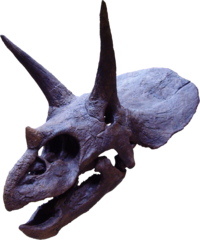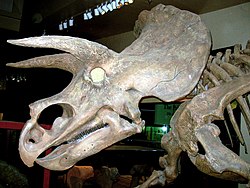| Revision as of 05:18, 8 August 2006 editBallista (talk | contribs)6,564 edits →Depiction in popular media: remove bulleting - may need a rewrite now, to make it 'flow' better← Previous edit | Revision as of 10:01, 9 August 2006 edit undo84.254.15.200 (talk)No edit summaryNext edit → | ||
| Line 23: | Line 23: | ||
| See text. | See text. | ||
| }} | }} | ||
| '''''Triceratops''''' ({{IPA|traɪ'sɛ.ræ.tɒps}}) meaning 'three-horned face' (derived from the ] '''''tri -/τρι-''''' meaning 'three', ''''' |
'''''Triceratops''''' ({{IPA|traɪ'sɛ.ræ.tɒps}}) meaning 'three-horned face' (derived from the ] '''''tri -/τρι-''''' meaning 'three', '''''ceras/κέρας''''' meaning 'horn' and '''''-ops/ωψ''''' meaning 'face') was a ] ] ] ], from the Late ] ] (from around 70-65 million years ago) of what is now ]. It shared its landscape with the fearsome '']'', the ] dinosaur '']'' and the uncommon '']''. | ||
| Although no complete skeletons have been found, '']'' has been estimated to have been about ] (30 ft) long, ] (10 ft) tall and to have weighed around ] (12,000 lb). | Although no complete skeletons have been found, '']'' has been estimated to have been about ] (30 ft) long, ] (10 ft) tall and to have weighed around ] (12,000 lb). | ||
Revision as of 10:01, 9 August 2006
| The current WikiProject Dinosaurs collaboration article is Confuciusornis. The last article for collaboration was: Brachiosaurus. Feel free to cast your vote for the next article. |
| Triceratops Temporal range: Late Cretaceous | |
|---|---|
| File:Triceratops.gif | |
| Triceratops skeleton at the National Museum of Natural History. | |
| Conservation status | |
| Template:StatusFossil | |
| Scientific classification | |
| Kingdom: | Animalia |
| Phylum: | Chordata |
| Class: | Sauropsida |
| Superorder: | Dinosauria |
| Order: | Ornithischia |
| Suborder: | Marginocephalia |
| Infraorder: | Ceratopsia |
| Family: | Ceratopsidae |
| Subfamily: | Ceratopsinae |
| Genus: | Triceratops Marsh, 1889 |
| Species | |
|
See text. | |
Triceratops (traɪ'sɛ.ræ.tɒps) meaning 'three-horned face' (derived from the Greek tri -/τρι- meaning 'three', ceras/κέρας meaning 'horn' and -ops/ωψ meaning 'face') was a ceratopsid herbivorous dinosaur genus, from the Late Cretaceous Period (from around 70-65 million years ago) of what is now North America. It shared its landscape with the fearsome Tyrannosaurus, the armored dinosaur Ankylosaurus and the uncommon Torosaurus.
Although no complete skeletons have been found, Triceratops has been estimated to have been about 9 m (30 ft) long, 3.0 m (10 ft) tall and to have weighed around 5,400 kg (12,000 lb).
Discoveries and species

Triceratops was discovered by John Bell Hatcher, in 1888. Its declaration as a legitimate dinosaur came when an intact skull was found. It was named by Othniel Charles Marsh in 1889 (some time earlier, however, in 1887 near Denver, Colorado, USA, he had misidentified the Triceratops as a type of bison, giving it the name Bison alticornis). The sturdy nature of the animal's skull has ensured that many examples have been preserved as fossils, allowing variations between species and individuals to be studied. Triceratops remains have subsequently been found in Montana and Wyoming, in the USA and in Saskatchewan and Alberta, in Canada.
How many species?
In the first decades after Triceratops was described, various skulls were collected, which varied to a lesser or greater degree from the original Triceratops, named T. horridus by Marsh. Disoverers would write these up as separate species (listed below). Eventually, however, the idea that the differing skulls might be representative of individual variation within one (or two) species gained popularity. In 1986, Ostrom and Wellnhofer published a paper where they proposed there was only one species - Triceratops horridus. Part of the rationale is that generally there are only one or two species of any large animal in a region (e.g. elephant or giraffe in modern Africa). A few years later, Cathy Forster reanalysed Triceratops material more comprehensively and felt the remains fell into two species, T. horridus and T. prorsus, although the distinctive skull of T. (now tentatively Diceratops) hartcheri differed enough to warrant a separate genus.
Triceratops species:
- T. horridus Marsh, 1889 (type species)
- T. prorsus Marsh, 1890

- T. albertensis Sternberg, 1949
- T. alticornis Marsh, 1887 (originally 'Bison')
- T. eurycephalus Schlaikjer, 1935
- T. galeus Marsh, 1889
- T. ingens Lull, 1915
- T. maximus Brown, 1933
- T. sulcatus Marsh, 1890
Misassignments:
- T. brevicornis Hatcher, 1905 (=T. prorsus)
- T. calicornus Marsh, 1898 (=T. horridus)
- T. elatus Marsh, 1891 (=T. horridus)
- T. flabellatus Marsh, 1889 (=T. horridus)
- T. hatcheri Lull, 1907 (=Diceratops hatcheri)
- T. mortuarius Cope, 1874 (also nomen dubium; originally Polyonax; =Polyonax mortuarius)
- T. obtusus Marsh, 1898 (=T. horridus)
- T. serratus Marsh, 1890 (=T. horridus)
- T. sylvestris Cope, 1872 (nomen dubium; originally Agathaumas; =Agathaumas sylvestris)
Paleobiology
Paleontologists deduce, from the evidence of ichnites (fossilised footprints) of dozens of individual animals, that Triceratops lived in herds, similar to those of modern-day buffalo.
Dentition
Its food was plants and shrubbery and its snout consisted of a sharp beak, which would have enabled it to break up and eat very tough vegetation. This beak could also be used in self-defence, as in the case of the primitive horned dinosaur Protoceratops. Behind the beak, Triceratops had a series of teeth arranged in a shearing configuration. Triceratops teeth are among the most abundant fossils in the Late Cretaceous Period of Western North America (65 mya), suggesting that it was the dominant herbivore of the time.
Gait
Triceratops possessed a sturdy build, with robust legs and five-hoofed toes. It is estimated that Triceratops was able to run at around 24 km/h (15 mph), since its short legs meant it could not take long strides.
Horns and frill


The distinctive skull of Triceratops had a single horn on the snout, above the nostrils and a pair of horns approximately 1 m (3 ft, 4 in) long, above the eyes. The rear of the skull bore a relatively short bony frill. Most other frilled dinosaurs had large fenestrae in their frills, while the frill of Triceratops is noticeably solid.
A number of functions have been proposed for the frill:
- Defense against carnivores, such as Tyrannosaurus
- Communication between herd members
- Battling rival Triceratops over status, resources or territory
- Courtship display
- A status symbol which reflects (or determines) the individual's status in the herd
- Anchor points for the jaw muscles
- Increasing body area, to regulate body temperature (see also: thermoregulation)
In 2005, a BBC documentary, The Truth About Killer Dinosaurs, tested how Triceratops might have defended itself against large predators like Tyrannosaurus. To see if Triceratops could have charged other dinosaurs, as would a modern-day rhinoceros, an artificial Triceratops skull was made and propelled into simulated Tyrannosaurus skin, at 24 km/h (15 mph). The brow horns penetrated the skin but the blunt nose horn and the beak could not and the front of the skull broke. The conclusion drawn was that it would have been impossible for Triceratops to have defended itself in this way - instead, it probably stood its ground when attacked by large predators, using its horns for goring if the predator came close enough.
A recent study of the smallest Triceratops skull, ascertained to be a juvenile, shows the frills and horns developed at a very early age, predating sexual development and thus possibly important for visual communication and species recognition.
Depiction in popular media
Many (if not most) dinosaur movies have included Triceratops. One Million Years B.C. (1966) features Triceratops in a memorable but anachronistic battle with Ceratosaurus. In Jurassic Park (1993), an immobilized Triceratops is depicted as having a mysterious illness, the role given to a Stegosaurus in the novel. In the sequel movie, The Lost World: Jurassic Park, a Triceratops is captured but later set free, causing chaos.
A popular children's book is Oliver Butterworth's The Enormous Egg, where a friendly Triceratops hatches from an unusually large hen's egg.
Triceramon, a Digimon, is based on Triceratops.
Triceratops is the official state fossil of South Dakota, and the official state dinosaur of Wyoming.
In Japan's Super Sentai series, in Kyoryuu Sentai ZyuRanger, Dan's, aka TriceraRanger, powers were symbolized by the Triceratops. Later in Bakuryuu Sentai Abaranger, Yukito Sanjyou, aka AbareBlue (whose name is pun off of the Triassic period), also uses the Triceratops mecha.
Likewise in the Power Rangers series which were based off the cast of Sentai, in Mighty Morphin Power Rangers, the Triceratops was Billy Cranston's power source. In Power Rangers: Dino Thunder, the Triceratops was Ethan James's zord.
The Transformers characters of Slag, Triceradon and Guiledart each turn into a Triceratops.
The last episode of the mockumentary series Walking With Dinosaurs briefly featured the dinosaur as the meal of a Tyrannosaurus.
The 2005 BBC documentary The Truth About Killer Dinosaurs featured a Triceratops. It was put against a Tyrannosaurus in the first episode, with the Triceratops being the victor.
In The Land Before Time and its sequels, 'Cera' is a young Triceratops. Her father, an adult, is only shown.
In Diddy Kong Racing, a non-playable Triceratops character named Tricky was the boss of Dino Domain.
In the 1933 film King Kong, there was going to be a scene where Kong fights off a group of Triceratops, although this was never seen in the completed version. In the 2005 film, a fictional Triceratops-like dinosaur called Ferructus makes a quick cameo - it is seen drinking from a lake.
The first episode of the 2006 drama documentary Prehistoric Park featured Triceratops, besieged by Tyrannosaurus. A young Triceratops is also captured for the titular park.
References
- Ostrom, J. H., and P. Wellnhofer. 1986. The Munich specimen of Triceratops with a revision of the genus. Zitteliana 14: 111 - 158.
- Forster CA (1996): Species resolution in Triceratops: cladistic and morphometric approaches. J.Vert.Paleont. 16(2): 259-270
- Goodwin MB, Clemens WA, Horner JR, Padian K: The smallest known Triceratops skull: new observations on Ceratopsid cranial anatomy and ontogeny, Journal of Vertebrate Paleontology, 2006, 26(1):103-112
- Dodson, P. (1996). The Horned Dinosaurs. Princeton University Press, Pinceton, New Jersey, pp. xiv-346
External links
- Triceratops (short summary and good color illustration)
- Triceratops For Kids (a fact sheet about the Triceratops with activities for kids)
- Smithsonian Exhibit
- Triceratops Skull Picture